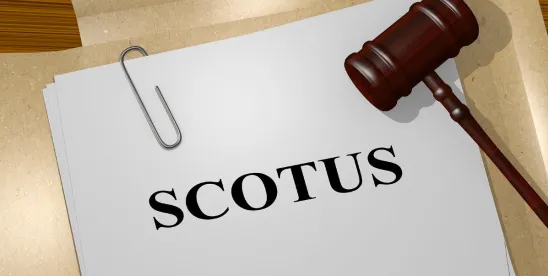Splitting along predictable philosophical lines, the Supreme Court held today in Garland v. Cargill that the Bureau of Alcohol, Tobacco, Firearms, and Explosives (ATF) exceeded its statutory authority by issuing a rule that classifies a bump stock as a “machinegun” under 26 U.S.C. §5845, a provision of the National Firearms Act of 1934.
Justice Thomas wrote the majority opinion, which was joined by all the Court’s conservatives. Justice Sotomayor, joined by Justices Kagan and Jackson, dissented.
It should be noted that while this decision, negating a Trump-era gun control regulation, certainly will be a centerpiece in the continuing political debate concerning firearms, the Cargill case is not a Second Amendment case. Like a chain of recent cases concerning the scope of congressional delegation to Executive Branch agencies and the clarity of text, this case, however consequential to public safety, is dependent upon the wording of the law that Congress wrote and the ATF’s authority to interpret it.
The National Firearms Act of 1934 defines a “machinegun” as “any weapon which shoots, is designed to shoot, or can be readily restored to shoot, automatically more than one shot, without manual reloading, by a single function of the trigger.” 26 U. S. C. §5845(b). A machine gun can be fired multiple times by engaging the trigger only once. A “bump stock” is an accessory designed to allow a shooter to fire a semiautomatic weapon at an accelerated rate, approaching that of a machine gun. However, employing a series of diagrams set forth in the opinion, Justice Thomas describes how a bump stock operates and, according to the majority, why it doesn’t alter the basic mechanics of bump firing because, in contrast to a machine gun, the gun’s trigger still must be released and re-engaged to fire each additional shot.
The Court notes that for many years, ATF consistently took the position that semiautomatic rifles equipped with bump stocks were not machine guns under §5845(b). The agency “abruptly changed course when a gunman using semiautomatic rifles equipped with bump stocks fired hundreds of rounds into a crowd in Las Vegas, Nevada, killing 58 people and wounding over 500 more.” At that point, ATF promulgated an amended regulation to “clarify” that bump stocks are machine guns. Cargill challenged this regulation, which required him to turn in weapons that he owned. The majority rejects ATF’s argument (which is the essential point of the dissent) that there is no meaningful difference between holding down the trigger of an acknowledged machine gun and maintaining continuous forward pressure on the front grip of a semiautomatic rifle equipped with a bump stock. Instead, claims Justice Thomas and his allies, the ATF ignores that Congress defined a machinegun by what happens “automatically” “by a single function of the trigger,” which is not how a semiautomatic rifle operates.
In a separate concurrence, Justice Alito suggests that it likely would have been the intention of Congress, if asked, to declare that there is no material operative distinction between a true machine gun and a bump stock-equipped semiautomatic rifle. But, according to Justice Alito, that is not the statute that Congress wrote. The dissenters, on the other hand, focused on likely congressional intent and argued, as we learned in high school algebra class, that things equal to the same thing are equal to each other.
As I noted at the outset, Cargill is not a Second Amendment case. Indeed, the point of the decision suggests that the area at issue is one that Congress would be entitled to regulate if only it had spoken more clearly. That is a criticism that echoes earlier discussions in this blog concerning the Major Questions doctrine and other delegation cases. The utter lack of deference shown to the ATF also might presage the result in the pending Loper case, in which the Court is considering the future of the Chevron doctrine. We’ll soon learn about that, as the current term is ending.
In Campos-Chaves v. Garland, a divided Court per Justice Alito (with Justice Gorsuch united with the three liberals in dissent) considered the removal from the United States of aliens who are either “inadmissible” under 8 U. S. C. §1182 or “deportable” under §1227. In such cases, the Federal Government must provide the alien with “written notice” either “to appear” at a designated time or place, or else must, “in the case of any change or postponement in the time and place of such proceedings,” provide “a written notice” specifying “the new time or place of the proceedings” and “[T]he consequences” of failing to attend. An alien who fails to attend a hearing despite receiving notice “shall be ordered removed in absentia.”
The aliens in this case received a proper §1229(a)(2) notice for the hearings they missed and at which they were ordered removed. The Court held that they cannot seek rescission of their in absentia removal orders on the basis of defective notice. In so holding, the Court agreed with the government that its single notice letter under either section of the statute defeats rescission. Justice Jackson, in dissent, is critical of the fact that Immigration and Naturalization Services traditionally has issued Notices to Appear (NTAs) that lack the exact time and date of a noncitizen’s removal hearing. Here, the majority has held that a noncitizen whose NTA does not contain the time and date information that §1229(a)(1) requires has no recourse from an in absentia removal order if the government otherwise and subsequently provides follow-up notice identifying the time and date of the proceeding he missed. The dissenters, claiming allegiance to the statute’s plain text, argue that this violates the “careful” regime that Congress has crafted.
This holding is of particular significance to immigration lawyers and their clients and suggests an enhanced level of vigilance for them. As an interpretive matter, the case is of broader interest because, on both sides, this is a pure battle of text, not legislative history or anything else. All litigators’ future arguments should be predicated on this increasingly evident feature of Supreme Court decisions.
To us generalists, perhaps the most interesting feature of the Court’s decision in United States Trustee v. Johan Q. Hammons Fall 2006, LLC, is the lineup of Justices. Here, Justice Jackson delivered the opinion of the Court, in which the Chief Justice and Justices Alito, Sotomayor, Kagan, and Kavanaugh joined, and Justice Gorsuch, joined by Justices Thomas and Barrett, dissented. That isn’t the sort of division that ideological critics of the Court criticize.
Today’s case resolves an issue left open two terms ago, in Siegel v. Fitzgerald, 596 U. S. 464, where the Court held that a statute violated the Bankruptcy Clause’s uniformity requirement when it permitted different fees for Chapter 11 debtors depending on the district where their case was filed. Today, the Court determined the appropriate remedy for that constitutional violation. Rehearsing Siegel, the Court described three options: (1) requiring refunds for thousands of debtors who were charged higher fees in districts administered by the U. S. Trustee Program, (2) retroactively extracting higher fees from the small number of debtors charged lower fees in districts administered by the Bankruptcy Administrator Program; or (3) as the government argued, only requiring prospective parity. The majority agreed with the government, holding that requiring, on a going-forward basis, equal fees for identical Chapter 11 debtors comports with congressional intent, cures the constitutional wrong, and satisfies due process.
The dissenters argue that the respondent Chapter 11 debtors should be entitled to a refund, which the majority styles as a judicial fiat undercutting the clear intent of Congress with respect to the metes and bounds of the program at issue. The dissenters claim that the majority misreads congressional intention regarding statutory text and otherwise contravenes an alleged promise of refunds made by the Government.




 />i
/>i

